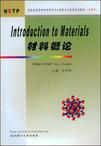材料概论
2005-11
武汉理工大
水中和
283
“材料概论”是材料类专业开设的一门必修课,属于材料类相关专业的技术基础课,通常安排在大一或大二讲授。这就要求该课程的内容注重基本知识和基本原理,且通俗易懂。编写本书的目的在于,通过本课程的学习,使学生增长一定的材料科学知识,同时也增加对材料科学与工程领域的兴趣,为今后的专业学习打下基础。所以,搞好本课程的教材编写和教学工作对于培养一批材料科学与工程领域的新生力量是十分重要的。近年来,不少学校先后推出了多种高水平的中文版《材料概论》和其他有关的教材,满足了材料类专业的教学需要。随着与国外大学的教学合作与交往的不断深入,双语教学也逐渐受到重视并率先在部分基础课和技术基础课中进行了尝试,取得了良好的效果。“材料概论”是我校最早被选定作为双语教学的课程之一,在教学内容选择、教学方法研讨等方面进行了有益的探索。但是,教材问题是长时间困扰该课程建设,影响该课程教学效果的重要因素。没有一本合适的双语教材,教师备课时没有一个确定的蓝本,学生学习时没有一个明确的依据,解决《材料概论》教材问题成为材料专业教学工作的燃眉之急。按照我们的理解,双语教学教材与专业英语教材有相似之处,但也有差别。显然,双语教材更侧重于专业知识的系统性和完整性,而外语在其中主要起到载体的作用,即双语教材的主要功能还是传递专业知识。可以想象,从浩如烟海的材料科学英文文献中筛选出符合教材要求且能保证章节之间有良好的协调关系的素材并非一件很容易的事情。本着一种探索和尝试,我们组织了几位有国外学习经历的教师编写了这本教材。我们作出了很大的努力,也进行了反复修改,但我们仍然怀着一颗忐忑不安的心来迎接读者的评价。
《材料概论》是普通高等学校材料科学与工程专业类“材料概论”或相关课程的双语教材。全书以国外著名的材料科学与工程著作和综述性论文为基础,以材料“结构-制备-性能-应用”为主线,系统介绍了材料科学与工程的基本知识、基本原理以及材料的应用技术。 全书共分七章,分别涉及材料科学基本知识、金属材料、陶瓷材料、玻璃材料、水泥混凝土材料、高分子材料和复合材料的有关内容。每一章由若干小节组成,每节又分为基本课文和阅读材料。在基本课文后附有部分专业词汇和注释,阅读材料中的疑难点在课文中加以注释。师生们在教学过程中可选择使用。 《材料概论》也可供从事材料研究与应用的人员作为了解专业知识、提高英语水平的阅读材料。
水中和,男,武汉理工大学材料科学与工程学院教授、博士生导师。曾先后获得原武汉建材学院和武汉工业大学(现武汉理工大学)学士和硕士学位。多年从事材料科学与工程的教学和科研工作。1996年9月赴荷兰代尔夫特理工大学(Dem university of Technology)土木与地球科学学院进修并攻读博士学位,2001年1月获该校博士学位。2001年6月至2002年6月任香港理工大学土木与结构工程系助理研究员,主要研究领域为生态建筑材料、水泥基复合材料、混凝土材料与结构的检测与评价。
1 Introduction to Materials1.1 Materials and Materials Science1.1.1 How Is Materials Defined1.1.2 The Three Classes of Materials1.1.3 Materials Properties1.1.4 Use of Materials1.1.5 Materials Science1.2 Types of Materials1.2.1 Metal1.2.2 Ceramics and Glasses1.2.3 Polymers1.2.4 Composites1.3 Structural Characteristic of Materials1.3.1 Crystal Lattice1.3.2 Crystallographic Indices1.3.3 Anisotropy1.4 Structure-property-processing Interaction1.4.1 properties1.4.2 Structure1.4.3 Processing 1.4.4 Structure-property-processing InteractionQuestions and ProblemsReferences2 Metallic Materials2.1 Metals2.2 Ferrous Metals2.2.1 Ferrous Metals Group2.2.2 Production of Iron2.2.3 Production of Steel2.2.4 Cast Iron Alloys 2.2.5 Steels2.3 Nonferrous Metals2.3.1 Introduction2.3.2 Nonferrous Metals in Common Use2.3.3 Titanium,Nickel,and Cobalt2.3.4 Other Nonferrous Metals2.4 The Physical and Mechanical Properties of Metals2.4.1 Mechanical Properties2.4.2 Metals at Low Temperatures2.4.3 Physical Properties2.5 The Crystal Structure of Metals2.5.1 Bonding of Metals2.5.2 Metals and Nonmetals 2.5.3 Crystalline Unit Structures2.6 CorrosionQuestions and ProblemsReferences3 Ceramic Materials 3.1 Introduction3.2 Nature of Ceramics3.2.1 Porosity of Ceramics3.2.2 Structure of Ceramics3.2.3 Ceramics Phase Diagrams3.3 Ceramics Processing 3.3.1 Traditional Processing 3.3.2 Advanced Ceramic Processing 3.4 Properties of Ceramics3.4.1 Mechanical Properties3.4.2 Physical Properties3.4.3 Chemical Proterties3.4.4 Fabricability3.4.5 Other Properties3.4.6 Designing Ceramics3.5 Application of CeramicsQuestions and ProblemsReferences4 The Glass Sciences4.1 The World of Glasses4.1.1 Natural Glasses 4.1.2 Glass in Modem Tirues4.1.3 Different Types ofGlasses4.2 Preparation Technologies of Glasses 4.2.1 Preparation ofGlasses4.2.2 Microwave Heating in Glass Preparation4.2.3 Sol-gel Process4.2.4 Chemical Nature of Glass Forming Materials 4.2.5 Stru&ural Approach to Glass Formation4.3 Structures and Properties of Glasses 4.3.1 Continuous RandOm Network Model 4.3.2 Random Close Packing Model 4.3.3 Bonding Tlheories4.3.4 Kinetic Criteria for Glass Formation 4.3.5 Thermal Behaviour ofGlasses 4.3.6 Physical Properties4.3.7 Optical Properties 4.3.8 Chemical Stability4.3.9 Electrical Nature ofGlass4.4 Applications of Glasses4.4.1 Glass Products4.4.2 Architectural GIass4.4.3 Anti.solar Glass4.4.4 Zero-expansion Transparent Glass Ceramics4.4.5 Glass for Active-matrix Liquid-crystal Display Panels 4.4.6 Fibre Optics 4.4.7 Fine Particulates and Nano—glasses4.5 Recent Topics of Optoelectronics Materials4.5.1 Blue and Green Light Sources 4.5.2 Optical Switches4.5.3 Optical FibersQuestions and Problems5 Cement and Concrete Materials5.1 Pbrtland Cement and Its Major Constituent Phases5.1.1 Portland Cement General 5.1.2 Types ofPortland Cement5.1.3 Cement Chemical Nomenclature and Other Abbreviations 5.2 Getting Acquainted with Concrete5.2.1 Properties Desired in Fresh or Plastic Concrete5.2.2 Properties Desired in Hardened Concrete5.2.3 Properties ofConcrete5.2.4 Variables That Influence Concrete Quality5.2.5 Consumer Product Safety5.3 Concrete:Strength and Behavior5.3.1 Introduction5.3.2 Uniaxial Behavior5.3.3 Tension Strength5.4 Uses of Concrete5.4.1 Reinforeed Concrete5.4.2 Prestressed Concrete5.4.3 Preeast Concrete5.4.4 Lightweight Concrete 5.4.5Thin Shell5.4.6 Shotcrete 5.4.7 Construction witll Prefabricated Concrete Units5.5 New Type of Cement.based Materials5.5.1 General5.5.2 DSP Concretes5.5.3 MDF CementsQuestions and ProblemsReferences6 POlymer Materials6.1 Polymer and Nomenclature6.1.1 Nomenclature Based on Source6.1.2 Nomenclature Based on Structure(Non-IUPAC)6.1.3 IUPAC Structure.based Nomenclature System6.1.4 Trade Names and Nonnames6.2 P0lymer Synthesis 6.3 Structure—property Relations6.3.1 General consideration6.3.2 Control of T and Tm6.3.3 Relation between T and Tm6.4 Mechanical Properties of Elastomers,Fibers,and Plastics6.4.1 Mechanical Properties6.4.2 Elastomers,Fibets,and Plastics6.5 Polymeric Biomaterials for Tissue and Organ Regeneration Questions and ProblemsReferences7 Composite Materials7.1 An Overview of Composites7.1.1 Introduction7.1.2 Definition of Composites 7.1.3 Materials ofConstruction7.2 Surface Treatment of Reinforcing Materials7.2.1 Cost Factor7.2.2 Chemistry 0fSutrace Treatment and Interfacial Structure 7.3 Mechanical Property of Polymeric Composite7.3.1 Introduction7.3.2 Polymer Matrix Composites 7.4 Smart Structural Composites 7.4.1 Cement-marx Composites7.4.2 Polymer-matrix Composites 7.5 Framework for NanoeompositesQuestions and ProblemsBefemnces
插图:
本书是普通高等学校材料科学与工程专业类“材料概论”或相关课程的双语教材。全书以国外著名的材料科学与工程著作和综述性论文为基础,以材料“结构—制备—性能—应用”为主线,系统介绍了材料科学与工程的基本知识、基本原理以及材料的应用技术。本书也可供从事材料研究与应用的人员作为了解专业知识、提高英语水平的阅读材料。

比想象的配送速度快很多。不错